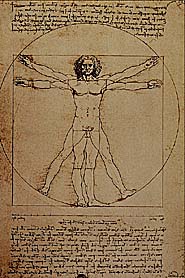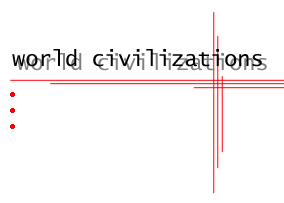|
|
Leonardo da Vinci (1452-1519) needs no introduction; if there is anyone who seems to embody the Renaissance completely and totally, it is this grouchy and self-centered painter, scholar, inventor, scientist, writer, anatomist, etc. He seems to span the whole of human knowledge as it was known at the time, and combine all this knowledge into this one vast, syncretic whole. So encompassing was his artistic and intellectual accomplishment, that the life and work of Leonardo traditionally marks the beginning of what historians call the High Renaissance.
For all this genius, however, he could never really finish very many projects (which seems to be a general rule prevailing among geniuses; they never finish projects, I think, because they get bored too easily), nor did he ever realize most of his inventions in real terms. As one surveys his notebooks (written backwards to prevent unwanted eyes from peering into his secrets), one find helicopters and submarines, hundreds of years before anyone else will think of them, but at no point does he sit down and actually build these marvelous inventions.
Born the illegitimate son of a lawyer and a peasant, Da Vinci established his own shop in Firenze and was so successful that by the age of twenty-five, he came under the patronage of Lorenzo de'Medici, the powerful ruler of Firenze. He and his patron, however, did not get along: Leonardo had an irritating habit of not finishing his work and Lorenzo the Magnificent had an irritating habit of wanting his commissions finished. So Leonardo left Firenze and came under the patronage of the Sforzas in Milan. There he worked at his own pace without interruption until the French invasions of 1499; eventually he came under the patronage of Francis I, King of France, in whose service he remained until his death in 1519.
In painting, his most famous works are La Gioconda (Mona Lisa ), The Last Supper ,, and The Virgin of the Rocks .. The Last Supper , painted in oils on plaster on the wall of the refrectory of Santa Maria delle Grazie in Milan, has weathered the years very poorly and is nearly unrecognizable, for oils fare very poorly on plaster. It is justly famous, for it is one of the most complex paintings in the Western tradition in depicting a variety of psychological reactions and internal states all focussed on a single, non-reacting center, the figure of Jesus of Nazareth. In the bewildering variety of reactions immediately following Jesus's announcement of his coming betrayal, Leonardo in visual terms manifests what Pico della Mirandola and others were saying about the variety and unpredictability of human beings.
|






